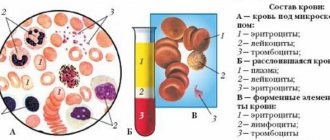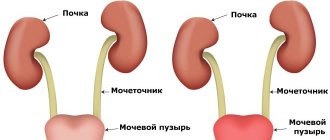In the Lab4U online laboratory, we want each of you to be able to take care of your health. To do this, we tell you about health indicators in a simple and clear way!
As a rule, the most common question at the stage of diagnosing a disease that arises from a pediatrician or therapist is whether the patient has a bacterial or viral infection? It turns out that during viral and bacterial infections, two different processes occur in the body. Therefore, the strategy for further treatment depends on the answer to this question.
Bacteria are poisonous opportunists
Bacteria are microorganisms that can take different forms:
- circle (“cocci” - pneumococcus, staphylococcus and others);
- oblong bacillus (dysentery and other diseases with a similar clinical picture);
- oval and others are much less common.
- Bacteria, unlike viruses, can develop independently.
- In the human body they find a suitable place for feeding and reproduction.
A myriad of bacteria live inside the human body and on its surface, but if the immune system is functioning normally, they do not pose a danger. However, with the slightest weakening of the immune system, they can cause the development of the disease.
- The bacterium itself does not cause much damage to the body; the toxic products of its vital activity - toxins (exotoxins) - are dangerous.
- The most dangerous exotoxins of all known, which cause diseases such as tetanus, botulism, anthrax, diphtheria, gas gangrene.
- Most bacteria produce toxins as they die and are called endotoxins.
- It is the specific effects of exotoxins and endotoxins on our body that explain the symptoms of each specific disease.
What will the analysis show?
The transcript will show that the action of bacteria causes an increase in the number of leukocytes in the blood at a norm of 4.0-9.0. This is caused by the work of neutrophils to fight infection, which are the first to rush to fight bacteria. When they die, they inform the body of danger and trigger the immune system. Dead neutrophils can be detected in a blood test. When infected with microorganisms, a general or biochemical blood test is prescribed.
Girls, the topic is not relevant for me now, but I just saw it on VKontakte and remembered what was discussed here. There I subscribe to the page of pediatrician Dmitry Izyakov, it can be useful to read him (link https://vk.com/pediatr_izyakov). Here is his message (though it is not based on tests, but on the course of the disease, as in the table above).
How to distinguish a bacterial infection from a viral one?
This skill has long been considered very valuable for antibiotic prescribing.
A study of the issue showed that the fact of a bacterial infection does not automatically mean antibacterial treatment. It is necessary that there is a bacterial disease that threatens complications or death without treatment.
However, for the prognosis of the disease, it is important for both doctors and patients to know the differences. As always, ten differences:
As always, ten differences:
1) Fever that debilitates the patient
With a viral fever, while the temperature drops, the patient feels quite tolerable. But with bacterial it’s even worse. This is due to the production of toxins and enzymes by bacteria that poison the body. And the less often the temperature rises, the stronger the poisoning. With viruses it’s the other way around - the less frequent the fever, the easier it is.
2) Increasing pain
The proliferation of bacteria, an increase in the focus of inflammation and the formation of pus gradually expands the tissues and puts pressure on pain receptors. Tissue destruction also causes pain. The release of pus often relieves the pain. Viruses can't do that.
3) Purulent discharge
from the eyes, nose, ears, in sputum, feces or in a wound. An undeniable sign of bacteria other than adenovirus.
4) Increasing difficulty in breathing
The most reliable sign of bacterial pneumonia and pleurisy. There is no increase in viral infections. It becomes difficult to inhale even if there is a bacterial outbreak in the stomach.
5) Increasing weakness
All the same poisoning of the body with bacterial toxins and the body’s own cadaveric poison of decaying tissues.
6) Neutrophils in fluid tests
Analysis of blood, urine, nasal swab, cerebrospinal fluid with a high content of neutrophils using conventional microscopy.
7) Increase in blood CRP.
It is not very reliable, so it has no independent significance. But it often helps when in doubt.
 Increased blood PCT.
Increased blood PCT.
An absolute sign of a bacterial infection.
9) Detection of bacteria by microscopy or PCR.
Correlates with neutrophils on liquid microscopy. Their combination reliably confirms a bacterial infection. Quick answer, but not 100% reliable.
10) Sowing bacteria
An absolute criterion for bacterial infection when it coincides with the clinical picture. But not at all fast.
Viruses are invisible invaders of human cells
Viruses are microscopic particles that border between living and nonliving organisms.
- They contain only one type of nucleic acid, DNA or RNA, and exist only inside human cells.
- The host cell processes viral genetic information as if it were its own.
- Viruses do not reproduce on their own; they create copies of themselves at great speed in living cells of the host.
- Thus, in each infected cell there are several thousand of them.
- As a result, the host cells die or become unable to perform their functions, which causes certain symptoms of the disease in a person.
It should be noted that viruses are selective: they capture only those cells that they can force to work for themselves.
- For example, the hepatitis virus can only multiply in liver cells,
- the influenza virus selects the mucous membrane of the bronchi or trachea,
- coronavirus selects lungs and blood vessels,
- The encephalitis virus multiplies in brain cells.
- Viruses do not always manifest themselves immediately; sometimes they are activated when the immune system is weakened.
- Some types of viruses (a striking example is HIV) cannot be resisted by the immune system.
Feature article
Every day the human body encounters various harmful microorganisms, such as fungi, bacteria, viruses. Thanks to the powerful round-the-clock protection of the immune system, pathogenic colonies are not allowed into the body. And if, nevertheless, a harmful agent happened to penetrate the human body, then faithful guardians of health await him fully armed? immune cells. But due to the fact that there are so many varieties of viruses, immune forces do not work against all types of pathogens. And harmful agents can, hidden, for years, or even decades, be present in the human body, waiting for the hour of attack, more precisely, when the immune system weakens. It is for such cases that a blood test for viruses is provided - in order to prevent an attack.
A BRIEF OVERVIEW OF THE CONCEPT OF VIRAL INFECTION
A virus is a microscopic particle of DNA or RNA nucleic acids. At their core, they are parasites that can only exist inside the cells of a living organism. Viruses cannot stay in the external environment for a long time, as they need a power source. Having penetrated human cells and prepared favorable conditions for parasitism, and this is only possible with weakened immunity, viral particles begin to clone themselves ad infinitum.
As long as the immune forces in the body are strong, they inhibit the process of viral reproduction. But as soon as the immune system weakens its position, lurking aggressive agents begin to act. Being in an inactive state, the viral elements do not manifest themselves in any way, and the person does not notice any symptoms.
In order not to wait for the decline of the body's defenses and the manifestation of parasitic aggressors, it is better to periodically do blood tests for infections, as well as for antibodies to viruses.
Most often, viruses are in the body only during illness. But there are types of viral agents that cannot be destroyed by either the immune system or medications. These are well-known viral infections, such as AIDS, hepatitis, papillomaviruses, herpes, adenovirus, rotavirus and others. For the time being, these pathologies can remain hidden in the human body without revealing themselves. The presence of such deadly microorganisms can only be determined by testing for viruses.
DIAGNOSIS OF VIRAL INFECTION
A general blood test can also show a virus in the blood. But a more detailed picture of a viral infection can be obtained not by a general clinical analysis of the blood substance, but by using the highly informative diagnostic methods of PCR or ELISA.
These two laboratory methods differ from each other in terms of the research mechanism; their only similarity is the high accuracy of the results obtained.
What diagnostic methods for testing blood for viruses are:
1. CBC, namely a general blood test, helps to detect the presence of a pathogenic process. With a viral infection, monocytes and lymphocytes will be higher than normal, and leukocytes and neutrophils may also be below the normal limit. The ESR coefficient in this case is normal or slightly increased.
2. ELISA, which stands for enzyme immunoassay of blood mass, is intended to identify antibodies or antigens to viruses in the test sample. A viral infection has markers of infection in the form of immunoglobulins IgA, IgM, IgG, produced by the victim’s immune system in response to foreign elements. By analyzing viruses using the ELISA method, it is possible to determine the form of infection: acute, chronic or asymptomatic. Thanks to enzyme immunoassay, it is also possible to monitor the effectiveness of the prescribed therapy.
3. PCR, that is, polymerase chain reaction, allows you to determine from the DNA of the virus what type of foreign agent it is. The PCR technique is based on molecular biology because it examines the genetic material of the pathogen. Thanks to this, it is possible to obtain not only confirmation or refutation of the infection and the type of aggressor, but also the number of viruses, as well as their sensitivity to certain medications. Such a detailed clinical picture contributes to making an accurate diagnosis and choosing an effective treatment method. Using polymerase chain reaction, almost all types of viruses and bacteria are detected. The PCR method has a 99% guarantee of reliability.
You can donate blood for a blood test for viral infections at any clinic that has a laboratory, or at a professional diagnostic center. There you can also find out the results of tests for viruses, but it is better if the attending physician deciphers the information received. Because to present a complete clinical picture, symptoms obtained during a survey and examination of the patient are also needed. In addition, auxiliary research methods may be needed, for example, ultrasound, MRI and other instrumental devices.
INTERPRETATION OF VIRUS TEST RESULTS
Interpretation of test results for a viral infection is permissible only with a qualified doctor
. Despite the reliability of the indicators obtained during the study of biological material using PCR, ELISA methods or biochemical blood tests. Nevertheless, impeccable knowledge in medicine and experience are needed to make the correct diagnosis, which determines the prescribed therapy.
In no case is it recommended to diagnose yourself, since without special knowledge you can easily make a mistake. And instead of a developing infection, start treating a completely different disease.
An untreated viral infection also poses a threat, in which case a relapse is possible.
In addition, there are options such as receiving a false positive or false negative test result for a viral infection. Such situations arise infrequently, but they do occur. There is a high probability of receiving such an answer if a person did not properly prepare for donating blood for viruses or did not carry out preparatory measures at all. There are mandatory requirements that must be met before performing a blood test.
Basic rules for preparing to donate blood for viruses:
— Blood is donated for viruses strictly in the morning, from approximately 7:30 to 9:30 am.
— The patient should not eat anything before blood collection. Juices, even herbal tea, coffee, and sweet carbonated drinks are also considered food. Only clean drinking water is allowed without any additives (squeezed juices, citrus slices, honey and similar ingredients).
- About 5-7 days before, you need to stop taking any medications. If it is impossible to stop taking medications, you must notify your doctor, who will prescribe a referral for a blood test.
- A week in advance, you will need to avoid alcoholic beverages or the use of tinctures containing alcohol for medicinal purposes. In addition, you will need to adjust your diet, eliminating all fatty, fried, pickled, smoked, etc. in a word, heavy food products.
— Smoking also negatively affects blood counts, but it is clear that it will be unrealistic for a smoker to last several days without tobacco smoke. Therefore, doctors recommend refraining from smoking at least 1-2 hours before taking blood for a blood test for viruses.
In addition to the listed conditions for obtaining reliable test results for a viral infection, it is also necessary to avoid emotional and physical stress. What wouldn't a person do? this will necessarily affect the condition and composition of the blood. This is why it is so important to prepare to get clear test results for various types of infections, both viral and bacterial.
Do not neglect preventive tests for viruses. Early detection of infection allows you to delay or suppress the development of the disease. In case of pregnancy, submitting biomaterial for analysis in order to detect viral infections is a mandatory procedure. The reason for undergoing the study may also be an increased level of leukocytes in the blood, a shift in the leukocyte formula, an increase in the number of neutrophils (band), myelocytes and metamyelocytes, a decrease in the number of lymphocytes with a high ESR in the results of a clinical blood test.
see Analyzes for allergens
see Blood tests for tumor markers
The most common viral infections
The most well-known illness is ARVI (acute respiratory viral infection), caused by rhinoviruses, coronaviruses or influenza viruses. The most common diseases include:
- Coronavirus.
- Influenza (flu virus).
- Colds, fever, catarrh or inflammation of the upper respiratory tract (rhinoviruses, coronaviruses).
- Herpes (herpes virus).
- Rubella (rubella virus).
- Measles.
- Poliomyelitis (poliomyelitis).
- Parotitis.
- Viral hepatitis - “jaundice” (hepatitis virus, , D, E, G, F, H - we are talking about various viruses that affect the liver, the most common are types A, B and, of which type can cause liver cancer).
- Papilloma viral infection (warts; some genotypes are also the cause of cervical cancer).
- Rabies (rabies virus, if antiserum is not submitted on time, is 100% fatal).
- AIDS (HIV, human immunodeficiency virus).
- Smallpox (smallpox virus).
- Chickenpox (herpes viruses, type 3 causes shingles).
- Fever, infectious mononucleosis (Epstein-Barr virus, cytomegalovirus).
- Hemorrhagic fever (Ebola, Marburg and others).
- Encephalitis.
- Atypical pneumonia.
- Gastroenteritis.
- Chlamydia.
Taking medications
It is important to take antibiotics in the presence of bacteria, when treating a virus - they do not have the desired effect. The only option for accurately determining the type of infection is to see a doctor. He will remove a particle of mucous membrane secretions or a throat swab and take it to the laboratory. If the doctor realizes that you need antibiotics, he will convince you of the presence of bacteria.
You can buy pain relief medications without a doctor's prescription.
If you have severe pain with both infections, talk to your pharmacist about the medications that are right for you.
If your doctor prescribes antibiotics, ask him if you can take painkillers at the same time. You should also get a flu vaccine. To prevent a recurrence of the flu, you need to get vaccinated. This way you will protect yourself from the influenza virus.
How to determine a bacteria or virus using a general blood test
The human body reacts to both the bacterium and its toxins in the same way as to viruses, producing antibodies.
- The causative agent of the disease, a bacterial or viral infection, can be determined by the results of blood tests.
- The blood characteristics of a sick and healthy person differ in basic indicators.
- Any deviations from the norm are a consequence of certain disorders in the body. A specialist will easily understand what was the true cause of these deviations.
- A complete blood count can show whether a bacteria or virus is causing the disease.
Main indications for prescribing tests
The appearance of a reddish rash of unknown origin on the body, irritation, itching, burning of the mucous membrane, soreness, discomfort in the lower abdomen and groin, unhealthy discharge from the genitals, poor appetite, constant fatigue, weight loss, regularly recurring colds - these are all indications for carrying out analyses.
If there are a lot of papillomas on the body, then it is necessary to do tests for viruses and to determine the type of virus. In some cases, everything can end in cancer.
Indicators of leukocytes and lymphocytes
- One of the main indicators is the level of leukocytes and lymphocytes:
- Leukocytes increase with infection of any etiology.
- But during a bacterial infection, it is neutrophils (this is a special type of leukocyte) that are increased.
- When the number of band neutrophils is increased, they speak of an acute infectious disease.
- But if metamyelocytes or myelocytes are detected, then the patient’s condition is characterized as dangerous and requires urgent medical attention.
- With the help of such diagnostics it is possible to identify the nature and stage of the disease.
- During a viral infection, leukocytes can be elevated, but most often they are lowered (including neutrophils), for example, with influenza, viral hepatitis, measles, rubella, mumps, and typhoid fever, leukocytes are necessarily below normal).
- But with a viral infection, an increase in the number of lymphocytes is necessarily observed, and an increase in monocytes can also be observed (with infectious mononucleosis, for example), so the result of a general blood test is assessed comprehensively.
Is it possible to distinguish between symptoms in children and adults?
Each infectious disease has its own symptoms, but they are often nonspecific. ARVI can be suspected by the following manifestations:
- Rapid onset of the disease.
- An increase in temperature in the first days (it can be significant - up to 39 degrees and even higher).
- The appearance of watery, transparent nasal discharge.
- The cough is initially dry, then it can transform into a wet one or stop on its own.
- Symptoms of intoxication are headache, aches in muscles and joints, weakness, loss of appetite.
- Recovery within 3–5, sometimes 7 days.
Viral diseases, as a rule, go away without treatment; doctors prescribe only symptomatic therapy - antipyretic, anti-inflammatory, analgesic.
You should think about a bacterial infection if the condition does not begin to improve within three days - the temperature persists, a sore throat persists, and a severe cough. Without special antibacterial treatment, the disease progresses, complications develop - bronchitis, pneumonia.
However, self-recovery is also possible, but at the same time there is a rather high risk of the pathology becoming chronic. Subsequently, with a temporary decrease in immunity against the background of hypothermia, stress, and concomitant ARVI, opportunistic bacterial microflora is activated and an exacerbation of a chronic disease develops. It often occurs with mild symptoms (as opposed to the acute form), but it is long-lasting and also requires antibacterial therapy.
Special tests for bacterial infection
Bacteriological research
- Bacteriological examination of biological fluid (discharge from the eye, ear, sinuses, wounds or sputum, for example). This test will identify the causative agent of the bacterial infection.
- Analysis of urine. Shows whether the urinary system is affected by bacteria, and is also necessary to determine the severity of intoxication.
- Bacteriological study with antibiogram. Many antibiotics have been developed to fight bacterial infections. But bacteria also have another unique feature - they mutate, adapting to new conditions and making it difficult to get rid of them. Using this analysis, the type of infectious agent is determined and what medicine can kill it (the so-called sensitivity of the pathogen to antibiotics is determined). These factors are important for prescribing the correct therapy.
Serological study
- Serological study. Based on the identification of antibodies and antigens that interact in a specific way. For such studies, venous blood is taken. This method is effective when the pathogen cannot be isolated, but the presence of special antigens in the blood will indicate it.
- The list of tests is determined by a specialist in accordance with the detected symptoms.
Additional examination
To clarify the result, in some cases, additional examinations are required: X-ray. CT. MRI. Ultrasound or laparoscopy.
Pros and cons of methods
Of course, serological studies have certain advantages. This is the speed of the study, this is the registration of changes in antibody titer, which indicates the intensity or involution of the infectious process, this is low cost and availability.
But on the other hand, serological methods also have disadvantages. So, if the disease has not yet developed, but infection has already occurred (that is, the patient is in the incubation period), then serological methods will not work, since the antibodies in the blood have not yet developed. Thus, when studying herpes viruses using serological methods, such as ELISA, only 2 weeks after infection, and sometimes later, can the presence of these antibodies be detected. At the same time, PCR will make it possible to determine that infection has already occurred even at an earlier date.
Blood test for procalcitonin - an indicator of bacterial infection
It is now possible to distinguish between bacterial and viral infections using a laboratory blood test for procalcitonin levels in order to correctly decide whether to prescribe antibiotics.
The procalcitonin test (PCT) has been used in Western Europe since 2000 and approved in the USA in 2005.
- The concentration of procalcitonin in the blood plasma increases in proportion to the severity of the infectious process, reaching a maximum in the case of sepsis (blood poisoning).
- Since the half-life of procalcitonin (the time it takes for half of the substance to be removed from the blood) is about 25-30 hours and is practically independent of kidney function, its level allows us to monitor the effectiveness of treatment of bacterial infections.
- With proper antibiotic therapy or after successful surgery, the level of procalcitonin in the blood decreases by 30–50% per day. If elevated procalcitonin levels persist for more than 4 days, treatment adjustment is necessary.
Diseases of the ENT organs
It is difficult for a person without medical education to differentiate a viral disease from a bacterial one.
Bacterial damage is indicated by:
- yellow or green snot from the first day of illness;
- skin rash that appears after or simultaneously with fever;
- white plaques on the tonsils;
- pain in the infraorbital or frontal region.
If the throat is simply red, there is redness in the eyes, and a sore throat - this is most likely a viral infection. It is wise not to start with antibiotics, but to observe for 1-2 days and start taking them, confirming with a general blood test.
DNA diagnostics, PCR blood test
- A PCR (polymerase chain reaction) blood test allows you to identify diseases in the human body that were caused by viruses or bacterial pathogens. PCR diagnostics allows you to detect the presence of, for example, the following infections in the body:
- Coronavirus.
- HIV;
- Tuberculosis;
- Epstein-Barr virus;
- Toxoplasmosis;
- Listeriosis;
- Shingles;
- Cytomegalovirus;
- Chlamydia;
- Tick-borne encephalitis and many others.
- In addition, the polymerase chain reaction can be used to diagnose viral hepatitis.
- The result of the study is always clear: either negative or positive.
How are viruses found in the human body?
So how to identify any virus in the body and find the cause of the disease? There are three main methods for this: PCR, or polymerase chain reaction, as well as enzyme immunoassay and serological methods, which are very similar studies. What are these methods of virological research?
PCR – diagnostics
This is the most advanced, most sensitive and specific way to determine an infectious viral agent in the body. It is based on typing the hereditary material of the virus. As you know, every living creature has its own unique genetic code, encrypted by a double helix of DNA, consisting of pairs of pyrimidine and purine bases. They encode the protein structure of the body. Viruses also have proteins that form their envelope, or nucleocapsid. Of course, there are also RNA viruses that cause certain diseases, but they can also be detected by this method.
The meaning of the method is to repeatedly copy or amplify the genetic signal with special enzymes, and then compare the resulting material with a database. As a result, the virus is identified with 100% accuracy.
The disadvantage of the method is that it is impossible to “release” enzymes into the sample, which can multiply copies of hundreds of viruses of different types at once. Therefore, you need to look for the specific pathogen that caused the infection. This means that the doctor can prescribe PCR for herpes viruses, Epstein-Barr, papillomaviruses, and so on. The PCR can be compared to a single-shot gun that shoots without missing, but is only used once each time. This means that the search for the second, third, and fourth viruses requires all new tests, and you have to pay for each one separately.
ELISA, or enzyme-linked immunosorbent assay, and antibody titration
With ELISA, it is no longer the specific culprit that is being looked for - the genetic material of the virus is not used in this analysis. ELISA uses the determination of antibodies in the blood that are produced by the human body as a response to the introduction of the virus. And the answer, as you know, can be different. In cases of immunodeficiency, antibodies may be produced in such small quantities that, despite infection, immunity to the virus will be reduced and the test will be false negative. In another case, the patient may experience a hyperergic reaction due to, for example, an allergy or an autoimmune disease, and as a result, there will be a false impression that the person is sick.
It becomes clear that enzyme immunoassay is a second-order study that relies on indirect data.
In fact, ELISAs are part of the general serological research method. All of them are aimed at identifying specific antibodies in the blood serum that are antiviral in nature. Thus, one of the types of serological reactions is the fluorescence reaction, or RIF. Here, the necessary antibodies are highlighted in the blood serum and become visible under a microscope.
In enzyme immunoassays, special labeled chemicals are added to antibodies.
Read more about ELISA in our article “ELISA analysis: what is it? why is it needed? pros and cons of the method."
ELISA - immunological blood test
- ELISA - Enzyme-linked immunosorbent test (ELISA) for diagnosing infectious, hematological, primary and secondary immunodeficiencies.
- The ELISA method has many advantages compared to other diagnostic methods:
- high sensitivity;
- storage stability of ingredients;
- speed of diagnostics;
- a small amount of the test material can be used;
- it is possible to automate all processes;
- infection can be detected at the earliest stages.
Symptoms of an attack by pathogenic bacteria
All bacteria are classified into:
- non-pathogenic - do not harm humans;
- opportunistic - coexist peacefully with humans until a certain point;
- pathogenic – dangerous bacteria that cause serious diseases.
In addition, all types of pathogens have different virulence. This means that under equal living conditions, one type of bacteria will be more toxic to humans than another.
The release of toxins (poisons) into the body is the most important point in the development of infectious diseases. Bacteria can produce endotoxins. This occurs in the event of cell death and destruction (intestinal infection). The second option for intoxication of the body is the release of exotoxins during the life of a bacterial cell (diphtheria).
Depending on the type of bacteria causing the infection, a person will experience different symptoms.
Depending on the location of the microorganisms, there are several types of bacterial infections, each of which manifests itself with different symptoms:
- Sexual infections in women. Some of the most common diseases are vaginosis, trichomoniasis, gardnerellosis, and yeast infection. Pathologies of the female genitourinary system as a result of changes in the vaginal microflora are manifested by the following symptoms: the formation of vaginal discharge of various characteristic colors and consistency, a burning sensation and itching, pain during urination, discomfort during sexual intercourse, a specific unpleasant odor. Female bacterial diseases can be provoked by douching, taking medications, changes in hormonal levels, decreased immunity, and frequent changes of sexual partners.
- Intestinal infection. It occurs as a result of the direct toxic effect of bacteria on the epithelium of the digestive tube and tissues of the gastrointestinal tract. Salmonellosis is characterized by increased body temperature, fever, abdominal pain, vomiting, and diarrhea. Staphylococcal intestinal infection occurs with a runny nose, sore throat, slight fever, loose stools, skin rashes, nausea, vomiting, and pain in the abdominal area. The general condition of the patient is similar to food poisoning. Typhoid intestinal infection - joints and throat hurt, loss of appetite, stomach pain. In severe cases - delirium, coma.
- Childhood diseases. The most common diseases are mumps, rubella, scarlet fever, measles, and tonsillitis. Toxins released by bacteria affect the child's internal organs. Symptoms of a childhood bacterial infection include: fever above 39°C, cough, general weakness, headaches, nausea, vomiting, plaque on the tongue and tonsils, skin rashes, severe intoxication of the body. To avoid complications, you must consult a doctor immediately. Children are almost always given antibiotics for a bacterial infection as treatment.
- Throat diseases. The following symptoms are characteristic of respiratory tract infection: deterioration in general health, a pronounced focus of the disease, purulent discharge, white plaque in the throat, low temperature at the initial stage of the disease. Often a bacterial throat infection is preceded by a cold. Bacteria can live in the body without showing themselves in any way, but after an acute respiratory viral infection, immunity decreases, and the rapid growth and reproduction of the pathogenic microbe begins. Effective treatment is impossible without taking antibiotics.
A decrease in immune defense is the main cause of many diseases caused by the fact that opportunistic microbes become pathogenic and very dangerous for the human body. Failure to promptly seek qualified medical help is fraught with serious consequences.
What is the difference between treatment for viral and bacterial infections?
Diagnosis, causes of disease, tests
Prescription of correct treatment, its effectiveness and the risk of complications directly depend on timely diagnosis.
- You should consult a doctor at the first alarming symptoms - at the appointment the patient is always prescribed tests.
- Test results help determine a viral or bacterial infection and choose the optimal course of treatment.
- It should be remembered that if the temperature persists for a long time, and the condition worsens after treatment, you need to consult a doctor and conduct additional examination. Since there can be a complication when a bacterial infection joins a viral one and vice versa.
General principles of symptomatic treatment
- Symptomatic treatment is similar for any infection: ensuring complete rest, bed rest and the use of drugs that affect the elimination of the symptoms of the disease.
Symptom difference
In order to understand the difference between a viral disease and a bacterial one, parents need to carefully monitor their child. The difference is noticeable already at the very initial stage.
- Most viral diseases have an acute onset
- the baby’s temperature rises to high levels (38.0-40.0 degrees), and he suddenly becomes ill. With the flu, the nose usually remains dry; with other acute respiratory viral infections, one of the first signs is liquid nasal mucus. This condition is described as “running from the nose.”
- Bacterial runny nose (rhinitis) differs in color, consistency and smell
. Snot with such a runny nose has a thick consistency, green or dark yellow color, sometimes with blood streaks, and an unpleasant smell of pus. The onset of a bacterial disease is not acute or abrupt. Usually the temperature does not rise immediately, but gradually, however, it can gradually reach high values, but more often it is subfebrile and long-lasting, and the state of health also gradually worsens. - With a viral infection, the general condition is disrupted literally from the first hours of illness
. There are signs of intoxication, muscle and joint pain, severe headache, and sometimes nausea and vomiting against a background of high fever. With a bacterial disease, the area of discomfort is usually localized quite clearly. If the bacteria infect the throat, a sore throat is observed; if it gets into the eyes, it is conjunctivitis; if it is in the lungs, it is pneumonia. Bacteria can cause meningitis and severe bronchitis. - The incubation period also varies
. Viral infections develop in the body after infection in a few hours or a couple of days, and bacteria need about 10 days to two weeks to “get comfortable”, multiply in sufficient quantities and begin to secrete large amounts of toxins.
- Almost any viral “sore” goes away on its own in 3-6 days in the absence of complications
. With bacterial ailments you will have to “tinker”; you usually cannot manage without a course (or even several courses) of antibiotics, and recovery is delayed. - People often refer to the symptoms of ARVI, acute respiratory infections, influenza and bacterial rhinitis or sore throat with the single word “cold”. This is wrong. A cold is nothing more than a weakening of the child’s immunity, made possible as a result of hypothermia. A cold may well precede a viral or bacterial infection, but is not considered an independent disease. A cold can be distinguished from a virus or bacteria by the absence of fever and acute catarrhal symptoms.
The only reliable way to distinguish one from the other, and at the same time find out which viruses or bacteria have infected a child, is laboratory diagnostics. Analysis of blood, urine, throat and nasal swabs is a sufficient basis for laboratory determination of either viral particles and antibodies, or specific bacteria.
You can learn more about how a viral infection differs from a bacterial infection from specialists below.
Knowing the differences between viral and bacterial infections is necessary due to the fact that these infections are treated differently. Bacterial infections are treated with antibiotics. Viral infections cannot be treated with antibiotics because they have no effect on them. If antibiotics are used in the absence of appropriate indications, the formation of resistant bacteria is possible. In addition, antibiotics often cause side effects, including the development of disturbances in the quantitative and qualitative composition of the microflora.
Differences in the prescription of special drugs
Principles of treatment of viral infections
Viruses cause a large number of serious infectious diseases.
- There is an effective vaccine against many of them, for example against polio, influenza, hepatitis B)
- against others, drugs have been developed that specifically block the viral enzyme (hepatitis C).
- But antibiotics do not have the slightest effect on viruses.
Treatment of bacterial infections
Bacteria can cause equally dangerous diseases - bronchitis, pneumonia or even meningitis.
- Therefore, determining the type of causative agent of the disease should be entrusted to a specialist who will not only identify the causative agent of the infection, but also prescribe the optimal treatment method.
- Fighting bacteria with antibiotics is essential to prevent severe disease progression.
- But remember, only a doctor prescribes these medications!
Conclusions:
1. A general blood test, as well as a bacteriological examination of one of the body fluids, will help to most accurately determine a bacterial infection.
2. If there are signs of a cold, but there is no plaque in the throat, and the eyes are red and clear snot comes out of the nose, this is a viral infection. Antibiotics are needed if the condition worsens.3. In many organs, pathology is caused only by bacteria: for diseases of the skin, kidneys and genital organs, antibiotics are prescribed based on the clinical picture.











